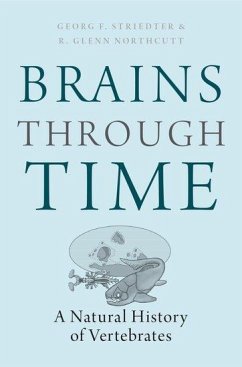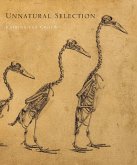Georg F. Striedter (Dept. of Neurobiology & Dept. of Neur Behavior, R. Glenn Northcutt (Dept. of Neuroscience, Dept. of Neuroscience, U
Brains Through Time
A Natural History of Vertebrates
Georg F. Striedter (Dept. of Neurobiology & Dept. of Neur Behavior, R. Glenn Northcutt (Dept. of Neuroscience, Dept. of Neuroscience, U
Brains Through Time
A Natural History of Vertebrates
- Gebundenes Buch
- Merkliste
- Auf die Merkliste
- Bewerten Bewerten
- Teilen
- Produkt teilen
- Produkterinnerung
- Produkterinnerung
This book encourages readers to view similarities and differences in various species as fundamental to a comprehensive understanding of nervous systems.
Andere Kunden interessierten sich auch für
![Refining Phylogenetic Analyses Refining Phylogenetic Analyses]() Pablo A. GoloboffRefining Phylogenetic Analyses115,99 €
Pablo A. GoloboffRefining Phylogenetic Analyses115,99 €![Evolutionary Cell Biology Evolutionary Cell Biology]() Michael R. Lynch (Professor and Director of The Biodesign InstituteEvolutionary Cell Biology119,99 €
Michael R. Lynch (Professor and Director of The Biodesign InstituteEvolutionary Cell Biology119,99 €![Unnatural Selection Unnatural Selection]() Katrina van GrouwUnnatural Selection49,99 €
Katrina van GrouwUnnatural Selection49,99 €![Evolving Tomorrow Evolving Tomorrow]() Prof Asher D. Cutter (Professor of Ecology and Evolutionary BiologyEvolving Tomorrow48,99 €
Prof Asher D. Cutter (Professor of Ecology and Evolutionary BiologyEvolving Tomorrow48,99 €![Game Theory in Biology Game Theory in Biology]() John M. McNamara (School of Mathematics, University of Bristol, UK)Game Theory in Biology70,99 €
John M. McNamara (School of Mathematics, University of Bristol, UK)Game Theory in Biology70,99 €![Random Process Analysis with R Random Process Analysis with R]() Marco Bittelli (Professor, Professor, Department of Agricultural anRandom Process Analysis with R69,99 €
Marco Bittelli (Professor, Professor, Department of Agricultural anRandom Process Analysis with R69,99 €![A Guide to Britain's Rarest Plants A Guide to Britain's Rarest Plants]() Christopher DixonA Guide to Britain's Rarest Plants32,99 €
Christopher DixonA Guide to Britain's Rarest Plants32,99 €-
-
-
This book encourages readers to view similarities and differences in various species as fundamental to a comprehensive understanding of nervous systems.
Hinweis: Dieser Artikel kann nur an eine deutsche Lieferadresse ausgeliefert werden.
Hinweis: Dieser Artikel kann nur an eine deutsche Lieferadresse ausgeliefert werden.
Produktdetails
- Produktdetails
- Verlag: Oxford University Press Inc
- Seitenzahl: 540
- Erscheinungstermin: 23. Januar 2020
- Englisch
- Abmessung: 261mm x 182mm x 32mm
- Gewicht: 1460g
- ISBN-13: 9780195125689
- ISBN-10: 0195125681
- Artikelnr.: 57613652
- Herstellerkennzeichnung
- Libri GmbH
- Europaallee 1
- 36244 Bad Hersfeld
- gpsr@libri.de
- Verlag: Oxford University Press Inc
- Seitenzahl: 540
- Erscheinungstermin: 23. Januar 2020
- Englisch
- Abmessung: 261mm x 182mm x 32mm
- Gewicht: 1460g
- ISBN-13: 9780195125689
- ISBN-10: 0195125681
- Artikelnr.: 57613652
- Herstellerkennzeichnung
- Libri GmbH
- Europaallee 1
- 36244 Bad Hersfeld
- gpsr@libri.de
Georg F. Striedter is Professor in the Department of Neurobiology and Behavior at the University of California, Irvine. He is the author of Neurobiology: A Functional Approach (2015) and Principles of Brain Evolution (2004). R. Glenn Northcutt is Professor in the Department of Neuroscience at the Unviersity of California, San Diego.
* Chapter 1
Reconstructing History: Aims and Methodology * 1.1
Comparative Approaches Outside of Biology * 1.2
The Comparative Method in Biology * 1.3
Comparative Approaches in Neurobiology * 1.4
The Importance of Natural History * Chapter 2
The origin of vertebrates: invertebrate chordates and cyclostomes * 2.1
The Origins of Neurons and Nervous Systems * 2.2
Basal Vertebrates and their Closest Invertebrate Relatives * 2.3
The Paleoecology of Early Chordates * 2.4
The Major Sense Organs of Early Vertebrates * 2.5
Movements and Motor Control * 2.6
Early Vertebrate Brains * 2.7
Developmental Mechanisms for Evolving a "New Head" * 2.8
The Question of Novelty in Evolution * Chapter 3
The origin of jaws and paired fins: the age of fishes * 3.1
Extant Jawed Fishes and Their Brains * 3.2
The Paleoecology of Early Gnathostomes * 3.3
The Sense Organs of Early Gnathostomes * 3.4
Gnathostome Movements and Motor Control * 3.5
The Brains of Early Jawed Fishes * 3.6
Evolutionary Changes in Telencephalic Connections * 3.7
Functional Synthesis * Chapter 4
The Invasion of Land: Lobe
finned Fishes and Amphibians * 4.1
The Lobe
finned Vertebrates * 4.2
Challenges and Opportunities on Land * 4.3
Sense Organs for Use on Land * 4.4
Movement On Land * 4.5
The Brains of Early Tetrapods * 4.6
Functional Organization of Early Tetrapod Brains * Chapter 5
The Conquest of Land: Amniote Origins and the Age of Reptiles * 5.1
Early Amniotes and Extant Sauropsids * 5.2
Ecological Challenges for Early Amniotes * 5.3
Enhanced Sense Organs * 5.4
Changes in Motor Patterns and Control * 5.5
Changes in the Brains of Sauropsids * 5.6
Novel Forebrain Circuits and Functions * Chapter 6
The rise of endothermy: Mammals, but also birds * 6.1
Extant Mammals * 6.2
Stem Mammals * 6.3
Synapsid Brain
body Scaling * 6.4
Paleoecology, Physiology, and Behavior * 6.5
Modified Sensory Abilities * 6.6
Breathing, Chewing and Moving Around * 6.7
Brain Enlargement and Reorganization * Chapter 7
Synthesis: Patterns and Principles * 7.1
Major Transitions in Vertebrate Phylogeny * 7.2
General Patterns of Evolutionary Change * 7.3
Trends in the Evolution of Brain Size * 7.4
The Evolution of Brain Region Size * 7.5
Changes in the Basic Plan of Vertebrate Brains * 7.6
Conclusion: Natural History through Time * Appendix * Index
Reconstructing History: Aims and Methodology * 1.1
Comparative Approaches Outside of Biology * 1.2
The Comparative Method in Biology * 1.3
Comparative Approaches in Neurobiology * 1.4
The Importance of Natural History * Chapter 2
The origin of vertebrates: invertebrate chordates and cyclostomes * 2.1
The Origins of Neurons and Nervous Systems * 2.2
Basal Vertebrates and their Closest Invertebrate Relatives * 2.3
The Paleoecology of Early Chordates * 2.4
The Major Sense Organs of Early Vertebrates * 2.5
Movements and Motor Control * 2.6
Early Vertebrate Brains * 2.7
Developmental Mechanisms for Evolving a "New Head" * 2.8
The Question of Novelty in Evolution * Chapter 3
The origin of jaws and paired fins: the age of fishes * 3.1
Extant Jawed Fishes and Their Brains * 3.2
The Paleoecology of Early Gnathostomes * 3.3
The Sense Organs of Early Gnathostomes * 3.4
Gnathostome Movements and Motor Control * 3.5
The Brains of Early Jawed Fishes * 3.6
Evolutionary Changes in Telencephalic Connections * 3.7
Functional Synthesis * Chapter 4
The Invasion of Land: Lobe
finned Fishes and Amphibians * 4.1
The Lobe
finned Vertebrates * 4.2
Challenges and Opportunities on Land * 4.3
Sense Organs for Use on Land * 4.4
Movement On Land * 4.5
The Brains of Early Tetrapods * 4.6
Functional Organization of Early Tetrapod Brains * Chapter 5
The Conquest of Land: Amniote Origins and the Age of Reptiles * 5.1
Early Amniotes and Extant Sauropsids * 5.2
Ecological Challenges for Early Amniotes * 5.3
Enhanced Sense Organs * 5.4
Changes in Motor Patterns and Control * 5.5
Changes in the Brains of Sauropsids * 5.6
Novel Forebrain Circuits and Functions * Chapter 6
The rise of endothermy: Mammals, but also birds * 6.1
Extant Mammals * 6.2
Stem Mammals * 6.3
Synapsid Brain
body Scaling * 6.4
Paleoecology, Physiology, and Behavior * 6.5
Modified Sensory Abilities * 6.6
Breathing, Chewing and Moving Around * 6.7
Brain Enlargement and Reorganization * Chapter 7
Synthesis: Patterns and Principles * 7.1
Major Transitions in Vertebrate Phylogeny * 7.2
General Patterns of Evolutionary Change * 7.3
Trends in the Evolution of Brain Size * 7.4
The Evolution of Brain Region Size * 7.5
Changes in the Basic Plan of Vertebrate Brains * 7.6
Conclusion: Natural History through Time * Appendix * Index
* Chapter 1
Reconstructing History: Aims and Methodology * 1.1
Comparative Approaches Outside of Biology * 1.2
The Comparative Method in Biology * 1.3
Comparative Approaches in Neurobiology * 1.4
The Importance of Natural History * Chapter 2
The origin of vertebrates: invertebrate chordates and cyclostomes * 2.1
The Origins of Neurons and Nervous Systems * 2.2
Basal Vertebrates and their Closest Invertebrate Relatives * 2.3
The Paleoecology of Early Chordates * 2.4
The Major Sense Organs of Early Vertebrates * 2.5
Movements and Motor Control * 2.6
Early Vertebrate Brains * 2.7
Developmental Mechanisms for Evolving a "New Head" * 2.8
The Question of Novelty in Evolution * Chapter 3
The origin of jaws and paired fins: the age of fishes * 3.1
Extant Jawed Fishes and Their Brains * 3.2
The Paleoecology of Early Gnathostomes * 3.3
The Sense Organs of Early Gnathostomes * 3.4
Gnathostome Movements and Motor Control * 3.5
The Brains of Early Jawed Fishes * 3.6
Evolutionary Changes in Telencephalic Connections * 3.7
Functional Synthesis * Chapter 4
The Invasion of Land: Lobe
finned Fishes and Amphibians * 4.1
The Lobe
finned Vertebrates * 4.2
Challenges and Opportunities on Land * 4.3
Sense Organs for Use on Land * 4.4
Movement On Land * 4.5
The Brains of Early Tetrapods * 4.6
Functional Organization of Early Tetrapod Brains * Chapter 5
The Conquest of Land: Amniote Origins and the Age of Reptiles * 5.1
Early Amniotes and Extant Sauropsids * 5.2
Ecological Challenges for Early Amniotes * 5.3
Enhanced Sense Organs * 5.4
Changes in Motor Patterns and Control * 5.5
Changes in the Brains of Sauropsids * 5.6
Novel Forebrain Circuits and Functions * Chapter 6
The rise of endothermy: Mammals, but also birds * 6.1
Extant Mammals * 6.2
Stem Mammals * 6.3
Synapsid Brain
body Scaling * 6.4
Paleoecology, Physiology, and Behavior * 6.5
Modified Sensory Abilities * 6.6
Breathing, Chewing and Moving Around * 6.7
Brain Enlargement and Reorganization * Chapter 7
Synthesis: Patterns and Principles * 7.1
Major Transitions in Vertebrate Phylogeny * 7.2
General Patterns of Evolutionary Change * 7.3
Trends in the Evolution of Brain Size * 7.4
The Evolution of Brain Region Size * 7.5
Changes in the Basic Plan of Vertebrate Brains * 7.6
Conclusion: Natural History through Time * Appendix * Index
Reconstructing History: Aims and Methodology * 1.1
Comparative Approaches Outside of Biology * 1.2
The Comparative Method in Biology * 1.3
Comparative Approaches in Neurobiology * 1.4
The Importance of Natural History * Chapter 2
The origin of vertebrates: invertebrate chordates and cyclostomes * 2.1
The Origins of Neurons and Nervous Systems * 2.2
Basal Vertebrates and their Closest Invertebrate Relatives * 2.3
The Paleoecology of Early Chordates * 2.4
The Major Sense Organs of Early Vertebrates * 2.5
Movements and Motor Control * 2.6
Early Vertebrate Brains * 2.7
Developmental Mechanisms for Evolving a "New Head" * 2.8
The Question of Novelty in Evolution * Chapter 3
The origin of jaws and paired fins: the age of fishes * 3.1
Extant Jawed Fishes and Their Brains * 3.2
The Paleoecology of Early Gnathostomes * 3.3
The Sense Organs of Early Gnathostomes * 3.4
Gnathostome Movements and Motor Control * 3.5
The Brains of Early Jawed Fishes * 3.6
Evolutionary Changes in Telencephalic Connections * 3.7
Functional Synthesis * Chapter 4
The Invasion of Land: Lobe
finned Fishes and Amphibians * 4.1
The Lobe
finned Vertebrates * 4.2
Challenges and Opportunities on Land * 4.3
Sense Organs for Use on Land * 4.4
Movement On Land * 4.5
The Brains of Early Tetrapods * 4.6
Functional Organization of Early Tetrapod Brains * Chapter 5
The Conquest of Land: Amniote Origins and the Age of Reptiles * 5.1
Early Amniotes and Extant Sauropsids * 5.2
Ecological Challenges for Early Amniotes * 5.3
Enhanced Sense Organs * 5.4
Changes in Motor Patterns and Control * 5.5
Changes in the Brains of Sauropsids * 5.6
Novel Forebrain Circuits and Functions * Chapter 6
The rise of endothermy: Mammals, but also birds * 6.1
Extant Mammals * 6.2
Stem Mammals * 6.3
Synapsid Brain
body Scaling * 6.4
Paleoecology, Physiology, and Behavior * 6.5
Modified Sensory Abilities * 6.6
Breathing, Chewing and Moving Around * 6.7
Brain Enlargement and Reorganization * Chapter 7
Synthesis: Patterns and Principles * 7.1
Major Transitions in Vertebrate Phylogeny * 7.2
General Patterns of Evolutionary Change * 7.3
Trends in the Evolution of Brain Size * 7.4
The Evolution of Brain Region Size * 7.5
Changes in the Basic Plan of Vertebrate Brains * 7.6
Conclusion: Natural History through Time * Appendix * Index








